July 14, 2012

MEXICO CITY(AP)— Archaeologists in Mexico City have unearthed the skulls and other bones of 15 people, most of them the children of traveling merchants during Aztec times. Researcher Alejandra Jasso Pena says they also found ceramic flutes, bowls, incense burners, the remains of a dog that was sacrificed to accompany a child in the afterlife and other artifacts of a pre-Columbian civilization.

Jasso Pena said Friday that construction was about to start on five buildings in a Mexico City neighborhood when the National Institute of Anthropology and History asked to carry out an excavation of the site first. Experts suspected the site was an important ceremonial center for the Tepanec tribe between 1200 and 1300. The influential traders living there were called Pochtecas. Archaeologists say excavation is continuing at the site. (Associated Press)

The Aztecs were a Pre-Columbian Mesoamerican people of central Mexico in the 14th, 15th and 16th centuries. They called themselves Mexica hence the Republic of Mexico and its capital, Mexico City, derive their names from the word “Mexica”. The capital of the Aztec empire was Tenochtitlan, built on raised island in Lake Texcoco. Aztec is a term used to refer to certain ethnic groups of central Mexico, particularly those groups who spoke the Nahuatl language and who achieved political and military dominance over large parts of Mesoamerica in the period referred to as the late post-Classic period in Mesoamerican chronology. Often the term “Aztec” refers exclusively to the people of Tenochtitlan, situated on an island in Lake Texcoco, who called themselves Mexica Tenochca or Colhua-Mexica.
The city of Tenochtitlan was truly magnificent. Its crime rate was extremely low, and it was almost impossible to find waste in the city. The city’s inhabitants were smart, and loyal to the city. The structures were amazing, including the Main Temple, the Great Pyramid, and many famous palaces. The Aztecs worked around things that were hard to come by, like food. Instead they maintained other jobs and traded with foreign countries. Everything about Tenochtitlan was wonderful, and the city stands out as one of the greatest empire of all time. Tenochtitlan was built according to a fixed plan and centered on the ritual precinct, where the Great Pyramid of Tenochtitlan rose 50 m above the city. Houses were made of wood and loam, roofs were made of reed, although pyramids, temples and palaces were generally made of stone.
Ultimately many things were responsible for the fall of Tenochtitlan. The Spanish colonization of the Americas reached the Mexican mainland during the reign of Huey Tlatoani, Moctezuma II (Montezuma II). Even though the Aztec priests reported signs of doom, Montezuma thought Cortez was a returning god. When the Spanish saw the gold items Montezuma offered to them as gifts, they wanted to conquer the city. Add to this many of the tribes at the borders stayed strongly independent from Tenochititlan rule which made it easier for the Spanish captain, Cortez to gain their allegiance to defeat the Aztecs. On August 13, 1521 Hernan Cortes and an allied army of Meso-American Indians that far outnumbered the defending Aztecs, conquered the Aztecs. Even though Tenochtitlan was well protected by Lake Texcoco, germ warfare, siege warfare, psychological warfare, and direct combat by Cortes and his army were overwhelming. The city fell to the Spanish and Cortes began to erase Tenochititlan’s existence. Subsequently the Spanish founded the new settlement of Mexico City on the site of the ruined Aztec capital. Although the city itself was destroyed, the memories and sheer beauty of the city will remain forever.


